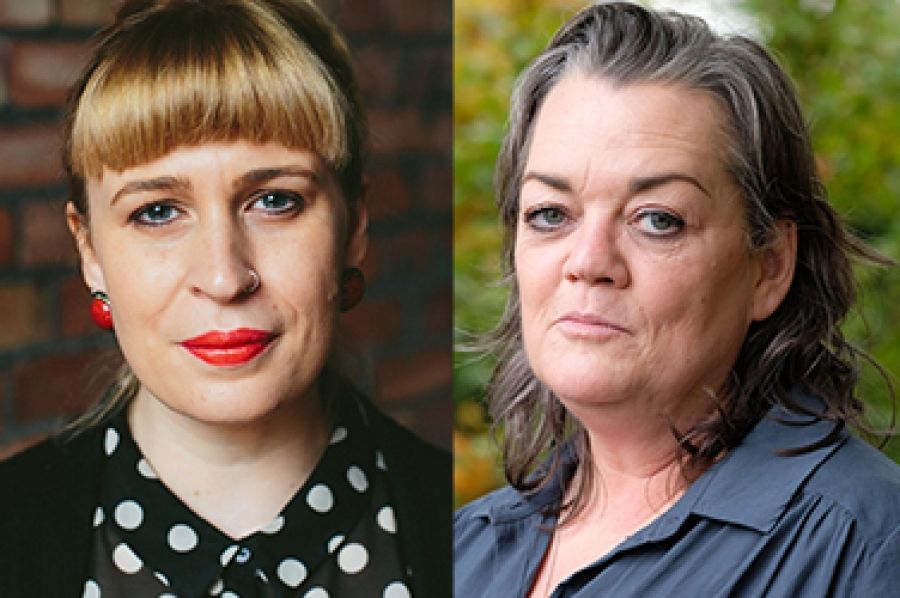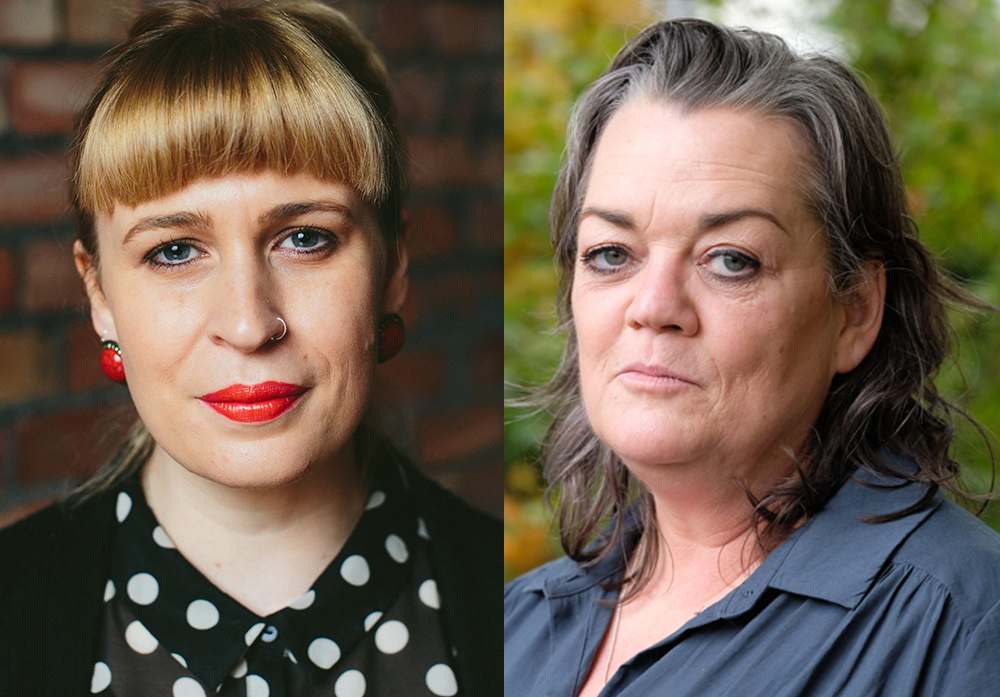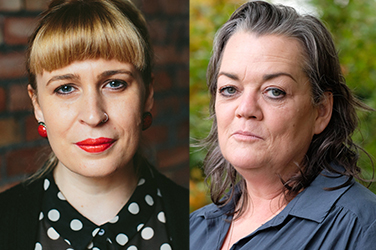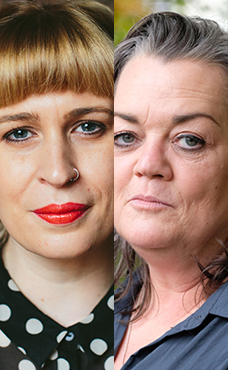
- Free Article: No
- Contents Category: Commentary
- Custom Article Title: Raking the past: Northern Irish fiction in the age of social media
- Review Article: Yes
- Article Title: Raking the past
- Article Subtitle: Northern Irish fiction in the age of social media
- Online Only: No
- Custom Highlight Text:
A ‘rake’ of fiction by women from Northern Ireland was published in the first months of 2022, much of which takes the Troubles as its focus, both directly and indirectly. ‘Rake’, a dialect word which crops up across these books, means a significant quantity or gathering of something. ‘Rake’ can also mean to drive a car hard, like ‘hoon’ in Australian English.
- Article Hero Image (920px wide):

- Article Hero Image Caption: Northern Irish writers Jan Carson and Louise Kennedy (photographs via Penguin/Alamy)
- Alt Tag (Article Hero Image): Northern Irish writers Jan Carson and Louise Kennedy (photographs via Penguin/Alamy)
- Featured Image (400px * 250px):

- Alt Tag (Featured Image): 'Raking the past: Northern Irish fiction in the age of social media' by Gillian Russell
Carson and Kennedy reject the choice that Seamus Heaney made in his early poem ‘Follower’, when he changed the word ‘wrought’, in a line he’d first written as ‘My father wrought with a horse-plough’, to ‘worked’. ‘Once you think twice about a local usage you have been displaced from it’, Heaney wrote in an essay entitled ‘John Clare’s Prog’, ‘and your right to it has been contested by the official linguistic censor with whom another part of you is secretly in league’.
The title of Heaney’s essay, based on one of his Oxford Lectures on Poetry given in 1992, refers to John Clare’s use of ‘prog’ in his sonnet known as ‘The Mouse’s Nest’, which begins: ‘I found a ball of grass among the hay / & proged it as I passed & went away’. Though Heaney doesn’t mention it, ‘prog’, like ‘wrought’, is part of Ulster vernacular, meaning to poach or steal. As children in rural Northern Ireland in the 1960s and 1970s, my brothers would ‘prog’ bramley apples from a nearby farmer’s orchard. Clare’s use of ‘prog’ signals an act of incursion into someone or something else’s property, in this case that of a mouse or bird. When I read Clare for the first time I was pleasantly surprised to see familiar words such as ‘prog’, or ‘hirple’, meaning to limp, words that migrated along with the men and women from the English east midlands who colonised the north of Ireland in the early seventeenth century. ‘Wrought’, ‘boke’, ‘prog’, ‘rake’, and ‘bake’ (the latter meaning mouth or beak, as in ‘shut your bake’) are the flinty residues of Anglo-Saxon English that have combined with Scottish and Irish influences to form the Ulster vernacular. It’s a rich hybrid or mongrel idiom, so it is.
Carson and Kennedy are apparently more comfortable with the vernacular than Heaney was when he changed ‘wrought’ to ‘worked’. They think twice and then carry on with little or no regard for the ‘linguistic censor’, making literary capital out of what Kennedy has described as her ‘inner northern voice’. Born in Northern Ireland in 1967, Kennedy has lived in the south since 1979 after her Catholic family moved to escape the Troubles. Her grandmother owned a pub that was blown up twice in Holywood in North Down, a predominantly Protestant area. She has described leaving the North at this time as a kind of deracination, the most obvious sign of which was quickly losing her accent in order to fit in ‘down south’. Kennedy’s experience curiously parallels that of the actor and director Kenneth Branagh, whose family left
Northern Ireland in 1969 for Reading in England, and who also found it necessary to lose his accent. The shock of the Troubles for Branagh and his family was the subject of his Oscar-winning film Belfast (2021), shown in British cinemas at the same time as the ‘rake’ of fiction by women was appearing in bookshops.
Both Trespasses and Belfast are memory pieces, reimagining personal histories and recreating lost worlds. In Branagh’s case, this projection takes the form of the child Buddy who, as performed by Jude Hill, dazzles in this luminous black-and-white film, signifying the possibility of transcending circumstance and history (to become a knight of British theatre, perhaps). In the posters for the film, Buddy, wielding a wooden sword, seems to be flying. He belongs to a long line of ‘wee muckers’, cheeky swarming children whose presence in Northern Irish cinema goes back to Carol Reed’s IRA film noir Odd Man Out (1947), partly filmed in Belfast, which features actual street kids of the time.
The main character in Kennedy’s Trespasses is another projection, the young adult she never was in the 1970s, a Catholic twenty-four-year-old primary school teacher called Cushla Lavery. She has an affair with a much older married barrister, Michael Agnew, a Protestant with progressive, liberal leanings who has named his son Dermot and defends ‘terrorists’ of both sides in the courts. Agnew introduces Cushla to his friends by inviting her to teach Irish to them, Kennedy evoking a milieu of scrubbed dining tables, Aga stoves, and French tureens. The rituals of dining and sociability in the upper-middle-class Protestant professional classes of the 1970s, who were in many ways insulated from the Troubles, are contrasted with the meagre meals that Cushla vainly prepares for her alcoholic mother, immersed in grief for Cushla’s dead father.
Works such as Branagh’s Belfast and Trespasses can be seen as symptomatic of a long-delayed response to the Troubles. As well as being ‘expats’, Branagh and Kennedy are of a certain age – sixty-two and fifty-four – when past experience is at sufficient distance to enable ‘safe’ reflection on it. Branagh has said that his screenplay for Belfast was produced during lockdown in 2020, a time of constraint but also of crisis, the unfolding, quotidian urgency of which was analogous to that of wartime, or of the early days of the Troubles. Sometimes wars can take a long time to be processed in the literary imagination, such is the struggle between remembering and forgetting. The literature of World War I occurred in waves, from the ‘war books’ boom of the late 1920s and 1930s, to the canonisation of the war poets in the 1960s, to Pat Barker’s revisionary Regeneration trilogy of novels beginning in the 1990s. In Northern Ireland, the shock of the Troubles was initially marked in poetry, most notably Heaney’s North (1975) and the less well-known anthology The Wearing of the Black (1974), edited by Padraic Fiacc. The cover of this impassioned anthology wore a simple, even crude, image of heart of green and orange, fractured in two.
There was no commensurate body of prose fiction to compare with the urgency of poetry in the early years of the Troubles, though the 1990s the work of male writers such as Robert McLiam Wilson, Eoin McNamee, and Glenn Patterson became prominent, linked with a thriving market for thrillers and crime fiction, later made famous as ‘Belfast Noir’. The fiction and journalism of Glenn Patterson has engaged in many varied ways with the historicity of the Troubles – its prologue in the murders of Catholic barmen by the Ulster Volunteer Force in 1966 in The International (1999), the surrealism of the DeLorean experiment in Gull (2016), and (in his essays and journalism) Belfast’s emergence as a party city to rival Prague or Tallinn in the 2010s. His best book, That Which Was, was published in 2004 in the aftermath of the Good Friday Agreement of 1998. The novel’s main character, a ‘trendy’ Presbyterian clergyman in East Belfast, has to minister to a man who is convinced that he killed someone in the Troubles but can’t remember whom, where, or how he did it. Patterson adapts the conspiracy thriller to convey the strange zeitgeist of the immediate post-1998 period, in a way resembling the first moments of returning to consciousness after a nightmare. ‘That which was still had questions to ask of that which is to be’, as he said at the time. That Which Was is a historical novel struggling desperately to be historical, which is what makes it so memorable.
The success of Anna Burns’s Milkman, winner of the Booker Prize in 2018, suggested that there was perhaps sufficient distance from the Troubles, especially for readership outside Northern Ireland, for the topic to sell books and make reputations. The publication of Milkman coincided with the fiftieth anniversary of the beginning of the conflict and marked twenty years since the Good Friday Agreement, an occasion darkened by the murder in 2019 of the journalist Lyra McKee, a self-declared ‘ceasefire baby’. Milkman drew attention to work by Northern women writers such as Carson and Erskine, whose début short story collection, Sweet Home, widely acclaimed, was published in 2018. Stories by Erskine, Carson, and Caldwell appeared in the 2019 anthology Belfast Stories, edited by Paul McVeigh and Lisa Frank. In defining a collective literary response to Northern Ireland’s situation in the second decade of the twenty-first century, especially to a more ethnically diverse city, Belfast Stories deserves to be compared with Fiacc’s The Wearing of the Black.
This ‘rake’ of fiction in 2022 began with The Raptures by Carson published on 6 January 2022, followed in quick succession by Erskine’s Dance Move on 17 February, Caldwell’s These Days on 3 March, and Kennedy’s Trespasses on 14 April. (As I was writing this article, another novel ‘about a shitty wee town in Northern Ireland’, Factory Girls by Michelle Gallen, appeared in bookshops). Whereas in the 1970s the cultural event that was the publication of Heaney’s North was publicised in local and national newspapers such as The Observer and in literary journals such as the Times Literary Supplement or The Honest Ulsterman, book trade publicity is now dominated by the quotidian rhythms of social media and the more immediate presence of writers on the internet.
Twitter is these writers’ preferred platform for announcing their publications, book tours, and festival appearances, and also for disclosing aspects of their personal lives such as the fact that Carson is a fan of the hospital soap Holby City or that Kennedy is currently suffering from cancerous melanoma. Readers will comment on these writers’ Twitter feeds, usually to say how much they have liked the books, and the authors usually respond. Erskine is unfailingly gracious; Kennedy’s posts sometimes resort to Irish demotic to make their point, as on 22 June when she indicated that she would be ‘telling youse why youse need to wear sunscreen’ in an interview for Radio Ulster. On the same day, she commended Mick Lynch, the newly famous leader of the railworkers’ union in the UK, as a ‘fkn legend to watch’.
My involvement in these actual and virtual reading communities, which I suspect are mainly female, began with pre-ordering Dance Move, which I bought on the day it was published from an independent bookshop. To mark this (exactly for whom I wonder?), I tweeted a photo of the book in my flat, next to a bunch of flowers. I’ve also attended online book talks by both Carson and Kennedy. Soon, I’ll probably listen to what Kennedy has to say about sunscreen on Radio Ulster, though having lived in Australia for many years I don’t need to be convinced of the need to use it.
As an academic in an English department, studying texts mainly from the past, I cultivate a professional detachment that includes maintaining a separation between reading for work and reading for leisure. Though the latter kind of reading is tremendously important to me, probably more important than what I study, I have never gone so far as to pre-order a book or follow a writer on social media. My normal practice is relaxed enough to locate books by browsing in a bookshop or by following up a review in a newspaper. Now I know much more about these writers than I probably want or need to know such as Carson’s culinary adventures on a book tour to the Dominican Republic or her views on Lidl’s sharp vintage cheddar. I am seriously concerned though about how Kennedy is faring.
The particular one-sided relationship I have developed with these writers is due not only to the faux intimacy of Twitter, but also to the curious historical coincidence of the publication of their books, sometimes within days of each other – a mini-tsunami of fiction I felt I needed to read. As with London buses, you wait for ages for a novel like Milkman, then four, five, or six come along in the space of a few months. Being there at the bus stop when they arrived, so to speak, has been important in adding another dimension to reading these books – an awareness of how they resonate with the sense of grief and isolation of the pandemic in which they were largely written, the continuing fragility of the Northern Ireland settlement, and also the war in Ukraine. Before ‘recovery’ could even begin to be contemplated in 2022, it seemed further away than ever.
Like Patterson’s That Which Was, these novels are historical fictions, more securely grounded in the ‘past’ than Patterson’s book because of ever-increasing distance from the immediacy of the Troubles. Caldwell’s These Days is set during the Belfast Blitz in April and May 1941. With echoes of Sarah Waters and Virginia Woolf, the novel spans the geography of Belfast, from Sydenham near Belfast Lough and the shipyards to the legendary Floral Hall, an Art Deco dance hall close to the Belfast Zoo looking down on the city from where the protagonists can see the German bombers coming in on their path of destruction. These Days digs beneath the layer of the Troubles to excavate a different but no less painful historical trauma, one not self-inflicted but visited upon Belfast by a foreign enemy. The Raptures begins in 1993 on the eve of the first IRA ceasefire and taps into the sense of the 1990s as a between times, bracketed by the ceasefire and the Good Friday agreement of 1998, a decade now indelibly associated with the fantasy of Northern Irish girl power that is the Derry Girls television comedy series.
Hannah, the eleven-year-old heroine of Carson’s novel, belongs to an evangelical Protestant family living in the small rural town of Ballylack in east Antrim, an area and a religious community that has been largely ignored by writers. Hannah is the opposite of the in-your-face Derry girls, a quiet ‘good girl’ whose world is shaken to its core when, one by one, her classmates fall sick and die of a mysterious illness. Her classmates visit her as ghosts to tell her of the otherworld they now experience, a Ballylack in which there are no adults and they can do what they like but which they can never leave. Hell is being stuck forever young in a boring Ulster village. The Raptures, like Caldwell’s novel, deals with the sudden visitation of suffering upon a community (relevant to both the Troubles and the pandemic). What happens to Hannah when she succumbs to the disease resembles the fiction of Marilynne Robinson in seeking, ambitiously, to explore explanations for human experience in religious terms, particularly the possibility of a miraculous transcendence of pain and suffering. Hannah’s fate is an allegory of a possible future for Northern Ireland at the end of the 1990s, the confidence of the murdered Lyra McKee, whom Carson invokes in her acknowledgments, that ‘it won’t always be like this. It’s going to get better’. However, any optimism that the novel might suggest is undermined by the historical fact of McKee’s murder, as well as the fate of Hannah’s teacher who echoes McKee’s words at the beginning of The Raptures and later succumbs to the disease and dies. In Northern Ireland hope is always hard to hold on to, always precarious.
Trespasses is more conventional than Carson’s novel in narrative terms, having no ghosts except for the real-life ‘living dead’ of the paramilitaries or Cushla’s grieving mother. As in The Raptures, the heroine of Kennedy’s novel survives. We encounter her in the ‘present’ when she meets the grown-up Davy McGeown and we learn that she is married with children and has had a ‘normal’ life. The darkly glittering 1970s Belfast of the novel, the roadblocks, the no-go areas, is only partially seen as Cushla moves across the city at night, often driven by Agnew. The locus and heart of Trespasses is Cushla’s parents’ bar, depicted in sensory detail, never more so than when Cushla arrives after the bar is bombed:
The carpet squelching beneath her feet, the high stools at the counter tossed aside, as if there had been a brawl. Shards of plasterboard dangling from the ceiling. The jade-green upholstery brackish from the firehoses, pieces of coloured glass scattered on the tables like boiled sweets. Behind the counter, bottles fizzling on the lino, oozing beer and ginger ale and stout. The shelves had collapsed. She began to lift pieces of debris, moving them aside with her hands and feet. She found the small plinth on which the whiskey dogs had sat; the Scottish border terrier was intact, a pair of chalky paws all that remained of the Westie. The bottle of green chartreuse. The Babycham fawn, which had under-eye circles of smoke.
A bar features in another episode of the book when Cushla goes with a work colleague to the Lyric Theatre to see a production of Brian Friel’s Philadelpha Here I Come! (1964) and encounters Agnew when they have a drink at the interval. Then, as now, the Lyric Theatre is situated in the Stranmillis area of Belfast, close to the university and the upper middle-class Malone Road. The main character of the play is played by ‘a big man with a north Antrim accent’, with ‘terrible anguish in his lines, in his delivery’. Kennedy does not make it explicit (perhaps anticipating a future scholarly note or some internet sleuthing) that the actor was a young Liam Neeson, then twenty-four years old.
I didn’t need to check this detail because I knew that the novel was referring to an actual event and specifically to Neeson, as I was there too. I was taken to see the play by a teacher and his wife, since I was studying a special subject on Friel for my A-levels. This was the first time I had been to the theatre, and the Lyric bar features significantly in my memory of the occasion as during the interval my teacher asked me what I would like to drink (I was old enough to have alcohol) and I nervously requested a Babycham. (Babycham, I discover from Wikipedia, was invented as a low-alcohol drink in the 1950s especially for women. It was marketed in television advertisements featuring the Bambi-like fawn that, besmirched, survives the bombing of the Lavery pub).
Kennedy was nine years old when Neeson appeared at the Lyric Theatre so it is unlikely that she saw him herself. She may be using the memory of a relative or friend, or she has thoroughly researched the cultural life of the liberal middle classes in Belfast in the mid-1970s. In a curious reversal of my following of Kennedy on Twitter, when I came across the Lyric Theatre episode I felt that she was uncannily following me. Going to see Philadelphia Here I Come! in 1976 was one of the stories of my growing up that I have told to myself and others over the years – seeing the then unknown Liam Neeson and my embarrassing choice of a Babycham because it was the only brand of alcohol I knew. The Lyric Theatre episode in Trespasses is important for how it explores the boundaries of class, confessional identity, and cultural knowledge that Cushla Lavery and Michael Agnew have to navigate. In 1976, I was taking my first baby steps in using education as a way of getting out of my equivalent of Ballylack (or Ballybeg in Friel’s play), inevitably entailing a scouring away of what Heaney called ‘local usage’, words such as ‘prog’ or ‘hirple’, phrases such as ‘I laughed into myself’.
Literary Twitter, as with many other aspects of social media, has intensified and amplified the affective investments we make in reading, especially prose fiction. We feel we ‘know’ the writers in very different ways than, for example, Heaney was known as a public figure in the 1970s. Via their Twitter posts, we get momentary glimpses into what these women are doing, thinking, feeling, or suffering, in ways that can make you feel like a voyeur, even of your own life, as Kennedy’s Trespasses did to me. The latter is freakishly accidental of course, but the coincidence renders it impossible for me to view the novel with the critical distance in which I was trained.
This ‘rake’ of books suggests how social media and the internet are transforming relationships between writers and their readers, especially in circumstances where, for some readers, history is still directly personal, still not safely confined to ‘the past’. Fiction can penetrate daily lives and experiences in unpredictable and unknowable ways that ramify the potential of the literary, for example in the way Lyra McKee is a de facto presence or ghost in The Raptures (as possibly I am in Trespasses). Historicity can assume a dizzying, vertiginous momentum, accessing the experience of the Blitz in These Days, for example, in ways that metamorphose the layers of Belfast’s many pasts and presents, making them indistinguishable.
Most importantly, social media reconfigures the temporality of the reading experience and ultimately what the book is, situating the ‘life’ of a book more emphatically within daily experience, with its white noise and profoundly meaningful but evanescent contingencies, thereby making the novel form itself more ephemeral. How will the literary scholar of the future be able to write a history of fiction by Northern Irish women in 2022 in these terms (if she wants to do so?). What will ‘the archive’ consist of? Inevitably the timeliness of these fictions will wane, but at this point I want that timeliness to keep going, to ‘like’ or ‘retweet’ the extended ‘book’ that Jan Carson and especially Louise Kennedy, for the meantime, keep writing.
This commentary is generously supported by the Copyright Agency’s Cultural Fund.



Comments powered by CComment